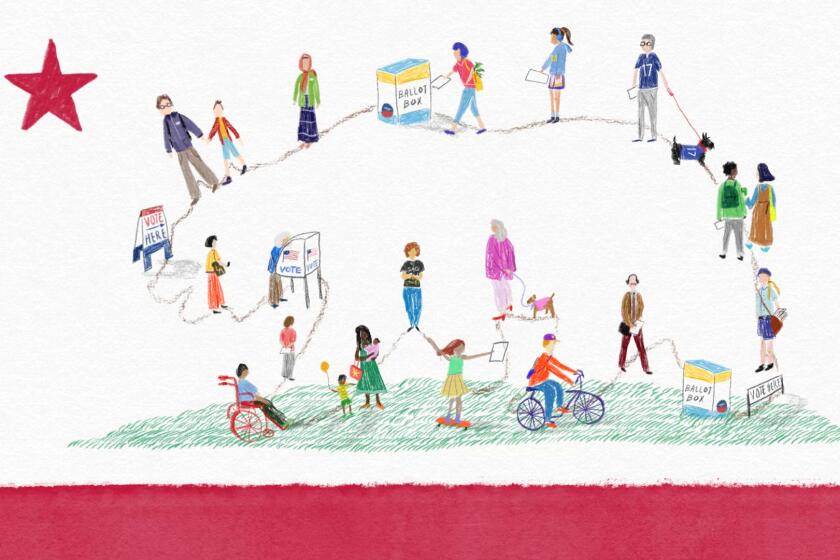Editorial: Prop. 47 may have given the sheriff more power to manage his jails. Or not. The county needs an answer

Los Angeles County Sheriff Jim McDonnell speaks at a news conference on March 9.
Who runs the Los Angeles County jails? It’s a more complicated question than it might appear. It’s also a crucial question, going to the heart of the county’s effort to combat rising crime, wisely manage its resources, make it own policies and balance the powers that the law and voters parcel out among elected officials. And because of Proposition 47, the initiative that changed six felonies into misdemeanors and drastically reduced jail overcrowding, it’s a very current and pressing question. Credit Supervisor Sheila Kuehl for asking it, and the Board of Supervisors for demanding an answer by May 10.
The quick but too simplistic answer is that Sheriff Jim McDonnell runs the jails, subject to a host of statutes and court orders that impose various restrictions and grant some interesting flexibility. But how much flexibility?
What Kuehl really asked earlier this month, as the board considered a host of actions meant to help the county adapt to Proposition 47, is whether McDonnell is required by law to hold people convicted of misdemeanors for their full sentences when crowding is reduced and he has enough space to avoid releasing them early. If he isn’t, then is it his policy — and is it the board’s — to hold people longer anyway?
Many people would respond that of course, if a person is sentenced to year in jail, that’s how long he should serve. But even that’s not as simple as it might seem. If there were enough space to keep a person convicted of a misdemeanor and sentenced to the maximum 364 days, he would serve six months behind bars, earn an equal amount of time in good conduct credits and then be let out. That’s not early release. That’s been California law for decades. Inmates can lose their good conduct time, but rarely do.
Actual early release comes into play because of overcrowding and means that the inmate won’t serve even that six months. The Rutherford overcrowding lawsuit brought against the county in the 1970s resulted in a court order that capped the jail’s population. To stay within the limit, the sheriff is authorized under the order to release some inmates before they have completed their terms. Until November 2014, when voters passed Proposition 47, it was common for a male Los Angeles County inmate convicted of a misdemeanor to serve only 20% of his time. On a one-year sentence, in other words, the person would serve just over a month.
Sheriffs ... enjoy broad power to control the supply as well as the demand for jail space by regulating the number of misdemeanor suspects their deputies arrest in the first place.
There’s no data to suggest that the practice was dangerous. In fact, when the percentages of sentences served were low, at least in recent years, so was crime. Now that the number is closer to 70%, crime happens to be up.
Sheriffs in 19 counties have population caps, and some have come to like them. After all, judges used to be the ones to dictate who was in jail and for how long. With their power over early release, sheriffs now get to make some of those decisions. In Los Angeles County, for example, people sentenced to less than 60 days don’t do any time at all. That fact has occasionally led to tension between the sheriff and judges, as when celebrity drunk drivers like Paris Hilton and Lindsay Lohan were sentenced to 30 days but were released in a matter of hours.
Fewer people are being arrested now, though, and jail space has been freed up. McDonnell argues that he has no choice but to keep his remaining misdemeanor inmates closer to their full sentences. That means, he argues, that the theoretical $41.6 million reduction in costs represented by the shrinking stream of inmates does not translate into an equal amount of savings. If there really is such a savings, some supervisors may want to spend it on alternative sentencing or other programs, or at least to know whether that’s an option.
As the county counsel studies Kuehl’s question, there are several points to keep in mind. For example, sheriffs are elected officials, traditionally accountable to the public for decision-making over the use of jail space in a way that state prison wardens are not. Also, sheriffs already enjoy broad power to control the supply as well as the demand for jail space by regulating the number of misdemeanor suspects their deputies arrest in the first place (so far in McDonnell’s tenure, arrests are down sharply). They can create scarcity by closing down a wing or moving mentally ill inmates to single instead of double bunks — a step McDonnell took recently.
State law also gives the sheriff power, independent of any population cap or judge’s sentence, to order part or all of a sentence to be served at home, and power as well to lop up to six weeks off jail time for participating in certain anti-recidivism programs. And the supervisors could, at any time, authorize McDonnell to free up space by releasing non-convicted inmates occupying bunks only because they can’t afford bail.
All such decisions — over what jail space to close off, what to free up, who serves time and for how long — ought to be made publicly and transparently, and with a common understanding of what the law requires. Only then will county residents have the means to hold each of their elected officials, the sheriff as well as the supervisors, accountable for their decisions in a way that, so far, they have not been.
Follow the Opinion section on Twitter @latimesopinion and Facebook
More to Read
A cure for the common opinion
Get thought-provoking perspectives with our weekly newsletter.
You may occasionally receive promotional content from the Los Angeles Times.










